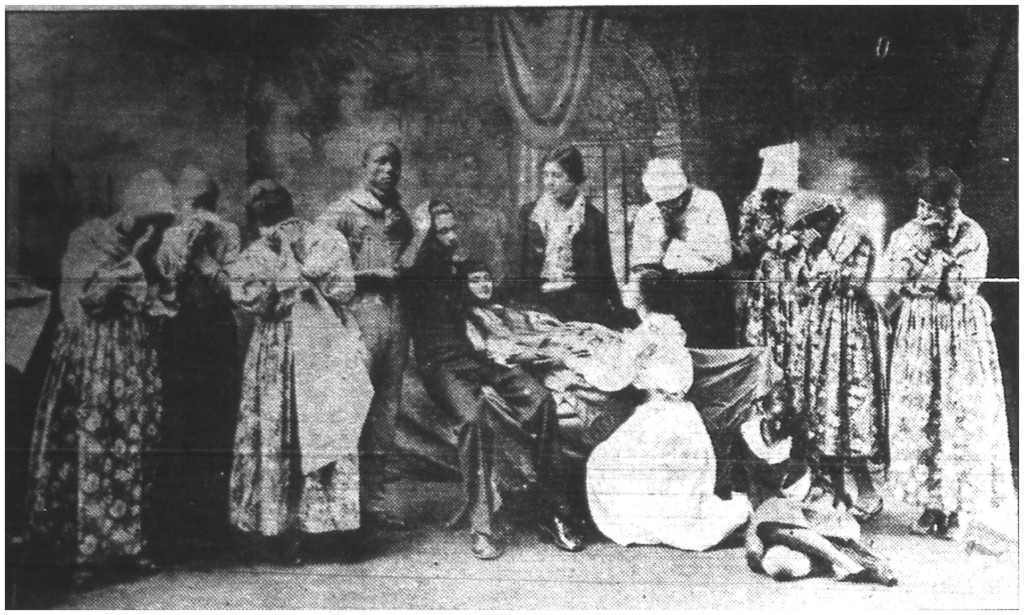Left to right: Annie Mae Young, Elizabeth Battin, Irma Perrault (Mammy); Eugene Alsandor (Uncle Tom); Roland Prejean (Mr. St. Clare); Lillie Mae Guillory (Eva); Lucy Mae Duplechain (Miss Ophelia); Eleanor Thierry, Arabella Byrd, Mary Emily Brooks, Beatrice Mantell, Lorena Payne, kneeling (Mrs. St. Clare); Margaret Harrison, seated (Topsy).
According to legend, upon meeting Harriet Beecher Stowe in 1862, Abraham Lincoln remarked “So you’re the little woman who wrote the book that made this great war.” In 1852, Mrs. Stowe, who came from a family of abolitionists, published a wildly popular novel Uncle Tom’s Cabin. The story revealed the horrors of slavery while asserting that Christian love can overcome something as destructive as slavery. The novel proved so compelling that many credit it with bringing anti-slavery sentiment to a fevered pitch.
Some sixty-five years after the Civil War, in February 1930, the students of Holy Ghost High School in Opelousas concluded their observance of Negro History Week with a staging of “Uncle Tom’s Cabin.” Negro History Week, established in 1926 by Dr. Carter G. Woodson and the Association for the Study of Negro Life and History, was the forerunner to Black History Month. Over the course of the week, between February 10-16th, 1930, the students at Holy Ghost, under the instruction of the Sisters of the Holy Family, performed Negro spirituals, plantation ditties, and skits on the history and future of the Negro.
The Senior Class was given the privilege of giving the culminating performance on Sunday, 16 February, before a large crowd in the auditorium of the school. The narrator, Miss Valerie Hebrard (later Mrs. Arthur Lewis), remarked, “The first scene … gives us a real conception of the atrocity and human injustice of the chattel slavery which remains a blot in the proud pages of American history.” Miss Hebrard announced the theme of the play as being that, “the love of Christ for all [was] the only hope of real freedom for the slave, as today, it is the only hope of real justice for his descendants.”
The student-actors were: Eugene Alsandor, Elizabeth Battin (later Mrs. Wilmer P. Frilot), Mary Emily Brooks, Arabella Byrd, Lucy Mae Duplechain (later Mrs. Lawrence H. Emerson; 50+ year educator), Lillie Mae Guillory, Margaret Harrison, Beatrice Mantell (40+ year educator), Lorena Payne, Irma Perrault, J. Roland Prejean (40+ year educator), and Eleanor Thierry. Many of these students went on to graduate from Xavier University or Southern University. Several of them had distinguished careers as educators, most notably Mr. J. Roland Prejean, a longtime principal in Opelousas.
The musical selections were provided by the Holy Ghost Student Orchestra, assisted by Miss Lucy Mack, and led by Mr. Leo Littell. Miss Mack (later Mrs. Joseph W. LeBlanc) went on to serve as an educator and for many years as the organist for Immaculate Conception Parish in Scotlandville.
Source: The Louisiana Weekly, 8 March 1930, page 4.
Jari C. Honora




God has always been our everlasting force. He has held our people together in years past as well as years since!!! We as a people should remember, revisit, recapture, and take hold of our past because it holds keys to our future!! Our history is our treasury!!!!
Valerie Hebrard is my grandmother, she was always amazing !
Beatrice Martel was my neighbor when I was 12 years old. I grew up around a lot of educators. Her grandson and I used to play together. Wow! That’s awesome to see that picture back from the 1930s.